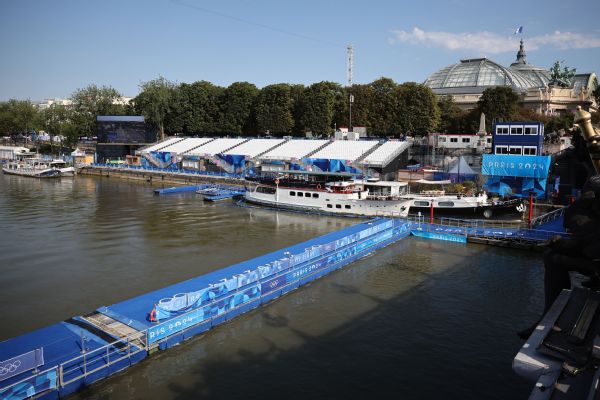
On a morning that started with rain, the Olympic triathlons were held Wednesday as the athletes dove into the Seine to swim after days of delays and uncertainty over water quality concerns.
The athletes began near the Pont Alexandre III, a bridge that spans the famed Paris waterway. The steady drizzle tapered off just as the athletes for the women’s triathlon splashed into the water. Some of the triathletes dunked their swim goggles in the Seine before putting them on and heading into the river with the Eiffel Tower in the background.
Cassandre Beaugrand of France won the women’s race — and the country’s first Olympic medal in the individual triathlon — finishing the run on top of the Pont Alexandre III bridge and collapsing to the ground in exhaustion and exhilaration.
“I have no doubts about the quality of the Seine. We’ve swum in worse water,” Beaugrand said after her victory, adding that scrapping the swim and holding a duathlon — the organizers’ last resort if the river had been too dirty — would have been “shameful” for the sport.
Beaugrand’s time of 1 hour, 54 minutes, 55 seconds edged Julie Derron of Switzerland by six seconds. Britain’s Beth Potter captured bronze.
Britain’s Alex Yee won gold in the men’s triathlon. New Zealand’s Hayden Wilde won silver, and Leo Bergere of France took the bronze.
The decision to go ahead with the swim for the triathlon competitions was a big win for the city, Olympics organizers and the athletes. Officials undertook an ambitious plan, including $1.5 billion in infrastructure improvements, to clean up the long-polluted Seine and have been steadfast in their insistence that the swimming portion of the triathlon and the marathon swimming events next week could safely be held in the river.
The organizers said early Wednesday that the latest tests of the water showed compliance with quality standards. But the early morning rain could have altered those figures.
“The problem is always worse when there’s a heavy rainfall, because it kind of overwhelms the pipes and you also get all the runoff from the street. All that lands in the Seine,” said Dr. Nicole Iovine, an infectious diseases specialist at the University of Florida. “They’ve done a lot to try to improve the quality of the water. But the truth is you’re at the mercy of Mother Nature.”
As they swam, the women stayed close to the barges and boats that line the banks of the river. Spectators watched and cheered form the stands set up along the side and from the bridges spanning the waterway. Reigning Olympic champion Flora Duffy of Bermuda was the first out of the water, taking about 22 minutes to complete the 1.5-kilometer course.
After swimming two laps in the Seine, the athletes emerged from the water and ran up a set of stairs to jump on their bikes for a ride through the rain-soaked streets of Paris, including the iconic Champs-Elysees. There were several wipeouts and spills early in the bike race.
Elevated levels of bacteria in the river pushed the men’s race originally planned for Tuesday to Wednesday, when the women’s competition had been scheduled. Test events meant to allow the athletes to familiarize themselves with the course were canceled Sunday and Monday due to the water conditions.
Every day since Sunday, even as organizers announced cancellations or postponements, they continued to express confidence that the swims in the Seine would go forward as planned the next day. For several days they did not publicly release the data on levels of E. coli and other bacteria that contributed to their decisions.
High levels of E. coli in water can indicate contamination from sewage. Most strains are harmless and some live in the intestines of healthy people and animals, but others can be dangerous. Even a mouthful of contaminated water can lead to diarrhea, and the germ can cause illnesses such as infections in the urinary tract or in the intestines.
World Triathlon’s water safety guidelines and a 2006 European Union directive give a range of E. coli levels from “excellent” to “sufficient.” Anything beyond 900 colony-forming units per 100 milliliters is not considered safe or “sufficient.” But experts stressed that these numbers are simply guidelines used to assess risk.
Aurélie Merle, the Paris 2024 director of sports, told reporters Tuesday that water samples are taken 21½ hours before decisions are made about the swim. That leaves uncertainty about their accuracy the day of the race.
Merle said Tuesday that testing results showed “we’re very close to the threshold of triathlon.” She noted that one of four test sites along the triathlon course was below the threshold for E. coli. Two other sites were just above the limit, and one was more elevated, she said, citing a range of 980 to 1,553.
“We know the sun and the heat have a very strong impact on the quality of the water,” she said, hoping that a heat wave that hit most of France on Tuesday would help improve water quality enough for the swims to go ahead.
Organizers have said the marathon swimming races, scheduled for Aug. 8 and 9, could be relocated, if needed, to the Vaires-sur-Marne Nautical Stadium in the greater Paris region, which already hosts rowing and canoeing competitions and can accommodate up to 15,000 spectators.
The Associated Press and Reuters contributed to this report.
